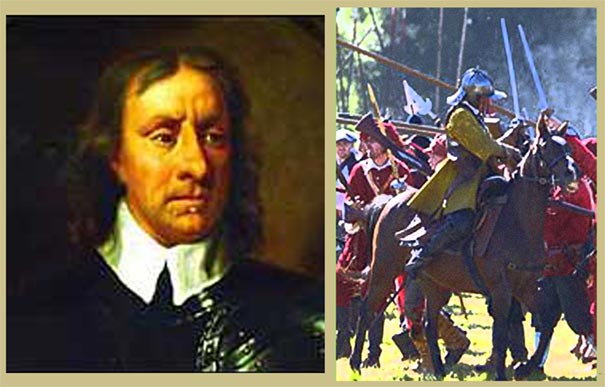English Civil War Timeline
From the Quicksilver Metaweb.
This is an intermediate page for English Civil War Timeline.
Stephensonia
Enoch Root forgot that Wilkins married Oliver Cromwell's sister.
Authored entries
Community entry: English Civil War Timeline
The English Civil War[1] broke out in 1642, largely as a result of an ongoing series of conflicts between the then King Charles I and Parliament. The Parliamentarian army was commanded by Oliver Cromwell, which after much bloodshed and destruction, was ultimately victorious. The capture and subsequent trial of Charles I led to his execution by beheading in January 1649 at Whitehall Gate in London.

Lord Protector Cromwell & Parliment Horse Guard
1642
The king, Charles I, raised his standard at Nottingham in what is accepted by historians as a sign by the king that he intended to fight Parliament for power in England. January 4 - Charles I attempts to arrest five leading members of the Long Parliament, but they escape. Beginning of English Civil War. His support came from the nobility, large landowners, the church and from people in the north and west of England.[2] July - Charles I besiges Hull in an attempt to gain control of its arsenal. In October, a battle was fought at Edgehill but neither side won it and from a military point of view it was an indecisive battle.[3]
[in science]: * Blaise Pascal produces a mechanical adding machine (the "Pascaline"). * January 8 - Galileo Galilei, Italian artist and scientist. * December 4 - Armand-Jean Duplessis Richelieu, French cardinal and statesman dies. * December 25 - Isaac Newton born.
1643
Oliver Cromwell was appointed the leader of Parliamentís cavalry. Parliament made an alliance with the Scots which threatened Charles from the north. Both sides won minor battles but none of them were decisive. July 13: Battle of Roundway Down - In England, Lord Henry Wilmot, Earl of Rochester, commanding the Royalist forces, wins a crushing victory over the Parliamentarian Sir William Waller. The Royalist forces supporting Charles I win the Battle of Adwalton Moor and gain control of Yorkshire.
[in science] - Evangelista Torricelli invents the mercury barometer.
1644
July 2 - Battle of Marston Moor , a crushing victory for the Parliamentary side ends Charles I 's hold on the north of England. September 2 - Second Battle of Lostwithiel, the last major victory for Charles I and the Royalist side in the English Civil War.
1645
The New Model Army was formed by Parliament. This exceptionally well trained force inflicted a severe defeat on the army of Charles at Naseby. The king lost his guns and ammunition at the end of this battle. July 2: Fight at Alford, Aberdeenshire. Siege of Ragban Castle Abergavenny.
In a political move, the Long Parliament outlaws the 1559 version of the Book of Common Prayer.
1646
Charles surrendered to the Scots in the hope that Parliament would fall out on what to do after Naseby. There was conflict in Parliament on how the church in England should be run.
1647
Parliament paid £400,000 to the Scots for Charles. But Parliament was still divided on what to do. As a result the New Model Army, lead by Fairfax and Cromwell, occupied London - a sign of their power. In November, Charles escaped to Carisbrooke Castle on the Isle of Wight. While here he made a treaty with the Scots. August 8 - The Battle of Dangan Hill, Irish forces are defeated by British Parliamentary forces. Castle of Aberystwyth razed to the ground by Parliamentarian troops. August: Army marches to London. December 28 , Charles promises church reform. This agreement led to the Second English Civil War.
1648
The Scots invaded England but were beaten at the Battle of Preston. Charles had shown that he could not be trusted and Cromwell was determined that he should be punished. In December, 100 MPs in Parliament voted to put Charles on trial. The English Parliament finds Charles I guilty of treason, and sentences him to be executed.
1649
Charles had a brief trial and was found guilty of treason. January 30 - King Charles I of England, Scotland and Ireland is beheaded. His widow Henrietta Maria resides in her native France. January 30 -- The Commonwealth of England, a republican form of government, replaces the monarchy as the form of government of England and later of Scotland and Ireland. Members of the Long Parliament serve as government. January 30 - Prince Charles Stuart declares himself King Charles II of England, Scotland and Ireland. At the time all three Kingdoms had not recognized him as ruler. February 5 - In Edinburgh, Scotland claimant King Charles II of England is declared King in his absence. Scotland is the first of the three Kingdoms to recognize his claim to the throne.
Birth of April 9 - James Crofts, illegitimate son of Charles II of England, later as James Scott, 1st Duke of Monmouth claimant to the thrones of England, Scotland and Ireland.
Related entries
- Charles I
- Charles II
- Monmouth
- Richelieu
- Hugh Peters
- John Wilkins
- Myles Coverdale
- Puritan
- Richard Cromwell
- Usurper
- Constitutional monarchy